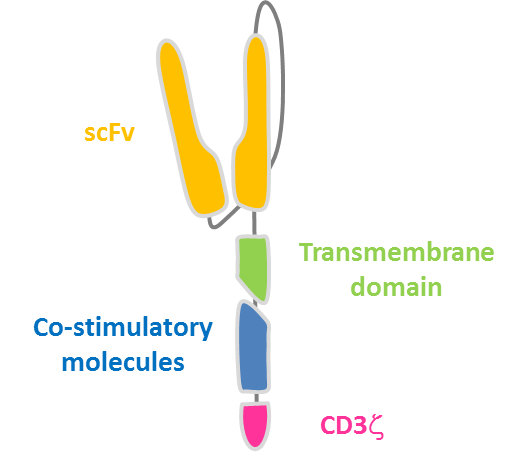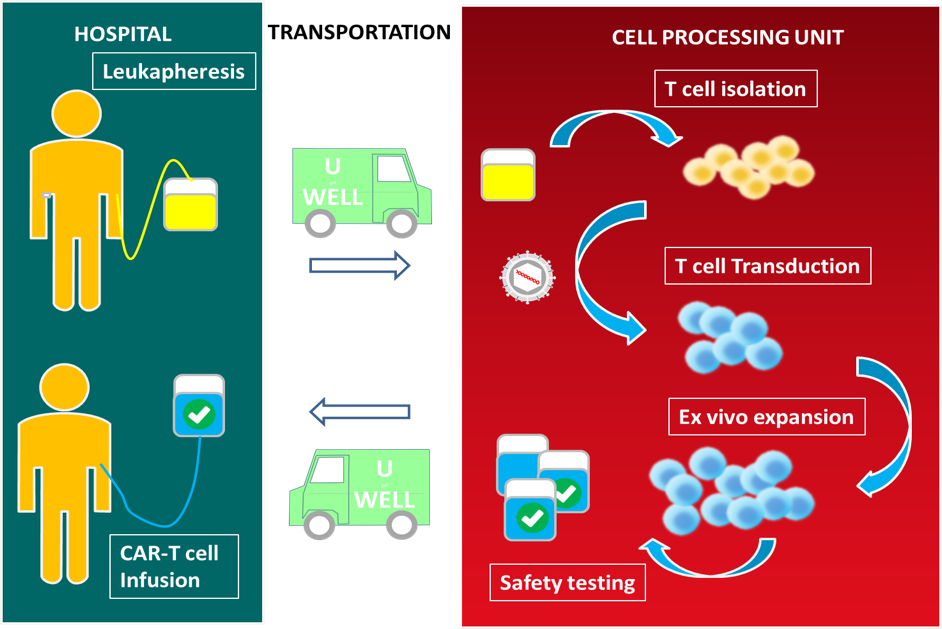What is CAR T cell therapy?
Chimeric antigen receptor or CAR T-cell therapy is a type of immunotherapy that employs genetically modified T Cells to more specifically target tumor cells.
Our body’s powerful immune system can protect us against cancer, and is capable of eliminating tumors that have formed.
Immune cells like T cells can hunt down and destroy abnormal cells, including cancer cells.
For a variety of reasons, however, they don’t always recognize cancer cells, or don’t mount an all-out attack on them, potentially allowing tumors to take root and expand.
Turning them into CAR T cells seeks to overcome those deficiencies.
Cancer cells generally develop mechanisms to escape from the immune system. This may include changes in shape, colour and configuration so that T cells fail to recognize them, leading to cancer growth.
CAR Receptors on CAR T cell recognizes tumor surface antigens like CD19, and thus are more efficient in attacking tumor cells and destroying them.

What is a CAR?
Chimeric Antigen Receptors are designed with domains derived from different origins, typically including an extracellular ligand binding domain, a transmembrane domain, and intracellular signaling domains.
The extracellular ligand binding domain confers target specificity. The intracellular signaling domains drive CAR T cell effector functions. For durable T cell activation, co-stimulatory signaling is also required.
CARs allow the expressing T cell to effectively kill target tumor cells1,2 and ideally to persist and provide ongoing immune surveillance.
How are CAR T cells manufactured?
For most patients, leukapheresis is an efficient centrifugationbased method for collecting large numbers of MNCs, including T cells.
The blood will be subsequently transported to a laboratory for CAR-T manufacturing. T cell yields vary significantly based on patient, disease and collection factors.
Particularly in patients with advanced malignancy who have an extensive treatment history, collection of T cells sufficient for the CAR T cell manufacturing cycle may be difficult.
 CAR-T 細胞製造生產流程圖
CAR-T 細胞製造生產流程圖
T cell enrichment from PBMC collection can occur via a variety of methods.
Density gradients can efficiently remove non-MNC contaminants such as granulocytes and red blood cells. Methods that separate based on both cell size and density can isolate lymphocytes from monocyte fractions.
Antibody bead conjugates can isolate pure T cell subsets with high specificity via magnetic separation.
Robust CAR gene delivery can be achieved with electroporation or viral vectors such as lentivirus.
T cells are stimulated using anti-CD3/anti-CD28 immunomagnetic beads to induce robust ex vivo expansion.
Release testing for clinical trials or clinical use to ensure the identity, purity, sterility, safety, and potency is based on assays and specifications described by the authority. Testing typically includes viability, immunophenotyping [including the percentage of CAR+ T cells], Gram stain, endotoxin, bacterial and fungal testing, and mycoplasma testing.
When the final cell product is formulated, samples are allocated for release testing, for infusible doses, and for archiving. CAR T-cell product will be delivered to the patient who has conditioning chemotherapy prior to the infusion and administrated intravenously.
For more information about this exciting new treatment, visit www.uwell.com.tw


